Our Trees
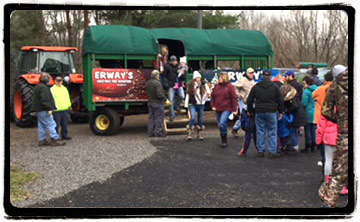 We
have WNY’s largest selection of fresh,
pre-cut and living Christmas trees
that can be set in your home for Christmas and planted outdoors
after Christmas. Enjoy a covered wagon ride through the tree
plantation to cut your own tree, or have one of Santa’s
helpers cut your tree at no additional charge. Our covered wagon
runs every 20 minutes to drop off and pick up hearty souls and
their trees. This is a great time to see our many fields of Nursery
Trees.
We
have WNY’s largest selection of fresh,
pre-cut and living Christmas trees
that can be set in your home for Christmas and planted outdoors
after Christmas. Enjoy a covered wagon ride through the tree
plantation to cut your own tree, or have one of Santa’s
helpers cut your tree at no additional charge. Our covered wagon
runs every 20 minutes to drop off and pick up hearty souls and
their trees. This is a great time to see our many fields of Nursery
Trees.
You get the following
for the price of a tree
at no extra charge:
Tree Shaking - to remove any loose needles.
Trunk Drilling - to accomodate tree stands.
Tree
Bale - netting machine wraps tree for easy transport.
Secure Car Tie - for a safe ride home.
Free Admission: Adventure Center, Nature Trail Adventure, Santa Visit
& Live Animal Feeding Area.
BIG Trees
Erway Farms is unique in offering a huge selection of large trees over 10 feet. With an extensive variety of tall pine trees to choose from, we have no doubt you will find your perfect tall tree for your home or business.
Delivery and set-up for a big tree is an additional charge.
Important Notes
![]() TREE FIELDS ARE OPEN FOR CUTTING UNTIL 4:30pm
TREE FIELDS ARE OPEN FOR CUTTING UNTIL 4:30pm
![]() FRESH CUT TREES ALWAYS AVAILABLE IN GREENHOUSE
FRESH CUT TREES ALWAYS AVAILABLE IN GREENHOUSE
![]() HAND SAWS ONLY!
HAND SAWS ONLY!
NO BATTERY POWERED OR CHAINSAWS PERMITTED.
NO SAW... NO PROBLEM. OUR STAFF WILL BE HAPPY TO CUT IT FOR YOU OUT IN THE FIELD!
![]() ONLY CUT TREES WITH COLORED BANDS. NO COLORED BAND, NO SALE!
ONLY CUT TREES WITH COLORED BANDS. NO COLORED BAND, NO SALE!
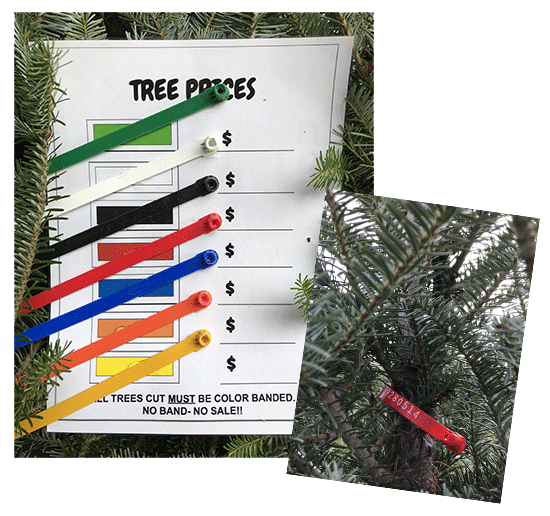
We have all your favorite varieties:
Tree information abridged from
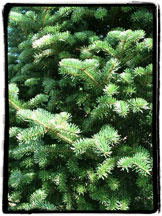 Balsam Fir
Balsam Fir
Balsam Fir (Abies balsamea) is a North American fir, native to most of eastern and central Canada (Newfoundland west to central Alberta) and the northeastern United States (Minnesota east to Maine, and south in the Appalachian Mountains to West Virginia).
This tree provides food for moose, American red squirrels, crossbills and chickadees, as well as shelter for moose, snowshoe hares, white-tailed deer, ruffed grouse and other small mammals and songbirds. The needles are eaten by some lepidopteran caterpillars, for example the Io moth.
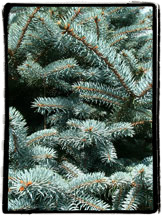 Blue Spruce
Blue Spruce
Picea pungens, also known as the Blue Spruce or Colorado Blue Spruce, is a species of spruce native primarily to the Western and North eastern United States, and south-central Eastern Canada.
P. pungens is a medium-sized coniferous evergreen tree growing to 82–98 ft tall, exceptionally to 151 ft tall, and with a trunk diameter of up to 4 ft 11". The bark is thin and gray, with narrow vertical furrows. The crown is conic in young trees, becoming cylindric in older trees. The shoots are stout, orange-brown.
Picea pungens and its many cultivars are cultivated as ornamental trees, and it is among the most widely planted ornamental spruces in gardens and parks. It is also grown for the cut Christmas tree industry.
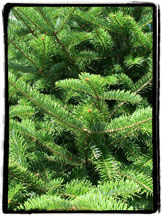 Canaan Fir
Canaan Fir
The name 'Canaan Fir' derives from one of its native localities, the Canaan Valley in West Virginia. Some botanists regard this variety as a natural hybrid between balsam fir and Fraser fir (Abies fraseri), which occurs further south in the Appalachian mountains.
Varieties of the species are very popular as Christmas trees, particularly in the northeastern United states. The resin is used to produce Canada balsam, and was traditionally used as a cold remedy and as a glue for glasses, optical instrument components, and for preparing permanent mounts of microscope specimens. The wood is milled for framing lumber, siding and pulped for paper manufacture.
The Canaan fir will grow up to 50 ft tall and 15 ft wide, and has the traditional evergreen shape and a very nice fir smell.
 Douglas Fir
Douglas Fir
Douglas-firs are medium-size to extremely large evergreen trees, 70–390 ft tall (although only Coast Douglas-firs reach such great height). The leaves are flat, soft, linear, 0.8–1.6"long, generally resembling those of the firs, occurring singly rather than in fascicles; they completely encircle the branches, which can be useful in recognizing the species. The female cones are pendulous, with persistent scales (unlike true firs), and are distinctive in having a long tridentine (three-pointed) bract that protrudes prominently above each scale (it resembles the back half of a mouse, with two feet and a tail).
The common name Douglas-fir honors David Douglas, the Scottish botanist who first introduced it into cultivation at Scone Palace in 1827. Douglas is known for introducing many North American native conifers to Europe.
 Fraser Fir
Fraser Fir
The Fraser Fir is a small evergreen coniferous tree growing to between 30 and 50 feet tall (rarely to 80 ft) with a trunk 16 to 20 inches across (rarely up to 30"). The crown is conical, with straight branches either horizontal or angled 40° upward from the trunk; it is dense when the tree is young, but becomes more open as it ages. The bark is thin and smooth, gray-brown with numerous resin blisters on young trees, becoming fissured and scaly with age. The foliage is strongly turpentine-scented.
The leaves are needle-like, arranged spirally on the twigs but twisted at the base to spread in two rows.
 Grand Fir
Grand Fir
Abies grandis (Grand Fir) is a fir native to the Pacific Northwest and Northern California of North America, occurring at altitudes of sea level to 1,800 m. It is a major constituent of the Grand Fir/Douglas Fir Ecoregion of the Cascade Range.
The tree typically grows from 40-70 m. There are two varieties, the taller Coast Grand Fir, found west of the Cascade Mountains, and the shorter Interior Grand Fir, found east of the Cascades. It was first discovered in 1831 by David Douglas.
The inner bark of the grand fir was used by some Plateau Indian tribes for treating colds and fever. The foliage has an attractive, citrus-like scent, and is sometimes used for Christmas decorations in the United States, including Christmas trees. It is also planted as an ornamental tree in large parks.
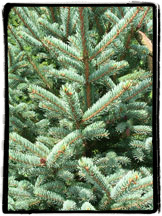 Meyer's Spruce
Meyer's SprucePicea meyeri (Meyer's Spruce) is a species of spruce native to certain provinces in China. It is a medium-sized evergreen tree growing to 30 m tall, and with a trunk diameter of up to 0.8 m. The leaves are needle-like, 13-25 mm long, rhombic in cross-section, bluish-green with conspicuous stomatal lines. The cones are cylindric, maturing pale brown 5-7 months after pollination, and have stiff, smoothly rounded scales.
It is occasionally planted as an ornamental tree; its popularity is increasing in the eastern United States, where it is being used to replace Blue Spruce, which is more disease-prone in the humid climate there. The wood is similar to that of other spruces, but the species is too rare to be of economic value.
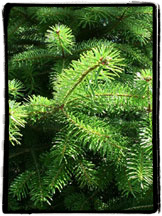 Nordmann Fir
Nordmann Fir
Abies nordmanniana, the Nordmann Fir, is a fir native to the mountains west and east of the Black Sea, in Turkey, Georgia, Russian Caucasus and northern parts of Armenia.
Current distribution of the Nordmann Fir is associated with the forest refugia that existed during the Ice Age at the eastern and southern Black Sea coast.
It is a large evergreen coniferous tree growing to 60 m tall and with a trunk diameter of up to 2 m. In the Western Caucasus Reserve, some specimens have been reported to be 78 m and even 85 m tall, the tallest trees in Europe.
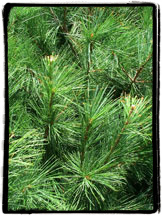 White Pine
White Pine
Like all members of the white pine group, Pinus subgenus Strobus, the leaves ('needles') are in fascicles (bundles) of five (rarely 3 or 4), with a deciduous sheath. They are flexible, bluish-green, finely serrated, and 2–5" long, and persist for usually about 18 months.
Mature trees can easily be 200 to 250 years old. Some white pines live over 400 years. A tree growing near Syracuse, New York was dated to 458 years in the late 1980s and trees in both Wisconsin and Michigan have approached 500 years in age.
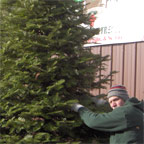
Need Something
Really Big?
We have 10-15
foot trees which are fresh cut or fresh pre-cut. And if you can’t get it home yourself we can make
arrangements for delivery and set-up.
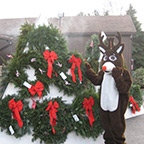
Fresh WreathS
Stop by the Wreath Barn where you can get beautiful wreaths,
swags and boughs. The natural scent of our fresh
cut greens will fill your home with a holiday fragrance
and ambiance.

Ready to Go!
Once you have selected your tree, we’ll shake it
in our machine to remove any loose needles, then bale
it in a netting machine and securely tie it on your car
for a safe ride home. We can also drill the trunk to accomodate
tree stands. All included with the cost of the
tree!
Tree Care
If you are purchasing your tree for the very first time, here are some helpful hints to prolong it's beauty and sustainability.
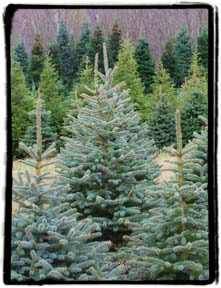 1.
Research your tree. Some tree varieties hold needles
far longer than others.
1.
Research your tree. Some tree varieties hold needles
far longer than others.
2. Make sure your tree can fit on the car for the ride
home and in your house once it is home.
3. Select a fresh tree without excessive needle loss.
Some interior loss is to be expected and occurs on trees still
planted firmly in the ground. And, when you take it home, keep
it out of the sun and wind in a cool location, such as an unheated
porch or garage. Then, when you decide the time to decorate
is right, make a one inch cut at the base of the trunk and place
it in a bucket of warm water. Bring inside after the tree soaks
up the water. Place in the stand full with water.
4. Place your tree away from heat sources that will
prematurely dry it out such as fireplaces, heat vents and radiators.
Also, place away from swinging doors that may touch the tree.
5. Always keep the stand full with water. A
seal of sap will develop if the tree is without water for more
than four hours, necessitating you to re-cut the base of the
tree. Avoid all this work. Keep the stand full of water. The
tree will absorb more than a gallon the first day and one or
more quarts thereafter. Water keeps the needles from dropping
and helps the tree to retain its fragrance.
6. Recycle your tree. Place the tree in the
yard with suet. The birds will thank you for the fancy dinner
and lodging.
Our Santa's Helpers are ready to answer any questions you may have about your tree!







